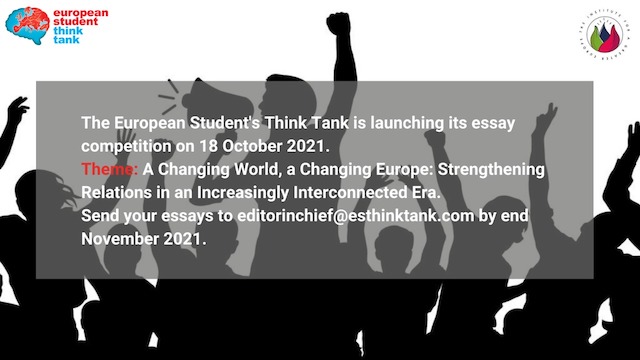
By Luigi Lonardo, PhD candidate in EU Law at King’s College London and writer for the European Student Think Tank.
The political action of the European Union (EU) on the international stage has been criticised in several instances: some authors have contended that traditionally the conduct of EU’s foreign policy has not lived up to the expectations created by European politicians. It is what Hill called “capability-expectations gap”.This “gap” is striking when taking into account the EU’s achievements in the domain of economic integration, which have not been matched by those in political international relations[2]. Why has it been the case? Could theories of economic integration explain this mismatch?
This post argues that the EU’s Common Foreign and Security Policy (CFSP), which is the technical term for the EU’s foreign policy, can be understood by drawing upon economic thought. In particular, theories of economic integration offer an interesting account of why the CFSP is lagging behind other economic achievements of the Union.. Firstly the work of Bela Balassa[3] and Tinbergen[4] on economic integration will be taken into account, then CFSP will be assessed.
The five stages of economic integration.
In Balassa’s theory CFSP may be the last stage of economic integration. According to the Hungarian economist, the degrees of economic integration of states or other state-like entities, like the EU, can be divided into five stages[5]. These stages are progressive, meaning that each of them is an improvement in economic integration with respect to the previous one[6]. We shall consider these in turn, with regards to the concrete case of the EU.
According to Balassa, the first stage of economic integration is a free trade area (FTA). A FTA is formed when at least two states partially or fully abolish all impediments to the exchange of goods between them. In other words, this stage is the abolition of custom duties between the states that are members to the FTA. A FTA implies that each state party retains competence to regulate its trading relations with non-member states. A FTA is the stage of integration currently subsisting among the Countries of the European Free Trade Area or the North American Free Trade Area. In the case of the European Union, a FTA was originally foreseen in Article 12 of the 1957 Treaty Establishing the European Economic Community (Treaty of Rome). The EU has reached that stage in 1968, and a provision was added in the 2009 Treaty on the Functioning of the European Union (TFEU). There is, however, a major consequence of a FTA. It may be the case that goods enter the FTA from a state with lower custom duties and that state then benefit from the principle of free circulation within the whole free trading area. A FTA prevents this from happening with the formation of a customs union (for the EU, the formation of a customs union was originally foreseen in the Treaty of Rome).
Secondly, a customs union is a FTA with a common commercial policy, such as a unified custom tariff at the borders of the union towards third parties. Article 28(1) TFEU provides that “the Union shall comprise a customs union […]”. Most famously, the European Union has also banned non-tariff barriers (quantitative restrictions and all measures having equivalent effects, Art 34-35 TFEU), anti-competitive behaviour (Art 101(1)-102 TFEU) and state aids (Art 107 TFEU) – all measures that could hamper free trade between the member states[7]. This is where the pioneering work of Tinbergen comes in handy; he was the first to make the distinction between negative and positive integration. “Negative integration” occurs when states agree not to hinder each other’s action in a given domain. Basically, it entails not “stepping on each other’s toes”. “Positive integration”, instead, means that the states will coordinate their efforts with the adoption of concrete, positive steps for the attainment of common objectives. For example, the creation of policies or institutions. In this respect, the creation of a custom union is the first step of positive integration.
Subsequently, the third step of economic integration is a common market, which ensures not only the free movement of products but also of means of production, namely workers and capital. These are the four freedoms provided for in the TFEU: free movement of goods, services, capitals and persons. As far as the EU is concerned the Delors Commission and the 1968 Single European Act SEA set the deadline for the completion of the Internal (or common) Market to 1992, which was to be achieved by the removal of physical, technical and fiscal barriers to trade.
Fourthly, an economic union combines a customs union with a common market and also requires “a high degree of coordination of economic policy, including macro-economic and monetary policies and possibly redistributive policies”[8]. In the case of a monetary union, the currencies of the member states are either fully convertible through fixed exchange rates, or, as it is the case for the Euro zone, are replayed by a single currency circulating in all states.
The fifth stage is complete economic integration, whichIn this case, integration extends further than economic policies, and spills over to other matters, most notably foreign policy and security. In these cases, integration is so close that it becomes almost impossible to distinguish the Union’s position from that of a nation state. Therefore, the mechanism of integration started with merely economic tools brings about close cooperation in domains that are quintessentially political, simply because the member states cannot afford any longer not to coordinate even the political choices. Balassa hoped that this final stage would be characterised notably by the presence of a supranational effective and democratic body. The EU has not yet reached this final stage: the member states do not speak with “one voice” in all political domains, and least so in foreign policy.
An integrated CFSP: matter of time?
In relation to the CFSP, loosely defined in the TEU as covering “all areas of foreign policy and all questions relating to the Union’s security, including the progressive framing of a common defence policy that might lead to a common defence”, complete integration is far from having been achieved. Not only does this domain have technical legal particularities that keep it differentiated from the Union’s other competences, but EU institutions are increasingly litigating before the Court of Justice of the European Union in order to have a say in CFSP: he scope of this policy, and consequentially the institutional involvement foreseen in it, is itself unclear.
When it comes to the legal technicalities that make foreign policy an exception in the EU constitutional landscape, for example, EU institutions play a different role in the CFSP than they do in other areas, even though there is no substantial difference in their composition or democratic legitimacy across the various domains of EU competence. These institutions were created for the purposes of economic integration – at least in the short run. Are they fit to act as institution of a political union? Moreover, the European External Action Service is a partial exception because it was created with the view of enhancing precisely political integration, as it is the diplomatic body of the Union. However, it is not an institution nor can it adopt legally binding acts.
So far, the EU is much integrated when it comes to economics, but the final leap to complete integration is yet to come. One may, at this stage, only speculate on what could be the factors that would allow the EU to reach the final stage of economic integration, complete economic and political union: further pressure from the international environment? More trust in international law which may foster the Union’s will to impose its voice on the international stage? Or maybe the need to express a unitary view on hot topics such as climate change?
[1] C Hill, ‘The Capability-Expectations Gap, or Conceptualising Europe’s International Role’ (1993) 31 JCMS 316. For an overview: T Risse, ‘Identity Matters: Exploring the Ambivalence of EU Foreign Policy’ (2013) 3 Global Policy 85
[2] E Duquette, ‘The European Union’s Common Foreign and Security Policy: Emerging from the U.S. Shadow (2001) 7 University of California at Davis Journal of International Law and Policy 169, 170
[3] B Balassa, The Theory of Economic Integration (Routledge 2013, 1st ed 1962).
[4] J Tinbergen, International Economic Integration (Macmillan 1954).
[5] B Balassa (n 3) 2.
[6] Each of these stages can exist of its own, without the need to be preceded or followed necessarily by the others. C Barnard, The Substantive Law of the European Union (OUP 2013) 9.
[7] Barnard (n 6) 9.
[8] Barnard (n 6) 13.

 The invention of development: power, narrative, and the afterlife of Truman’s speech
The invention of development: power, narrative, and the afterlife of Truman’s speech  Is the World Trade Organisation a Failure?
Is the World Trade Organisation a Failure?  Is EU citizenship for sale – or for keeps? A critical analysis of the CJEU’s Golden Visa ruling.
Is EU citizenship for sale – or for keeps? A critical analysis of the CJEU’s Golden Visa ruling.  The European Union in Space: From exploration and innovation to security and autonomy
The European Union in Space: From exploration and innovation to security and autonomy 


